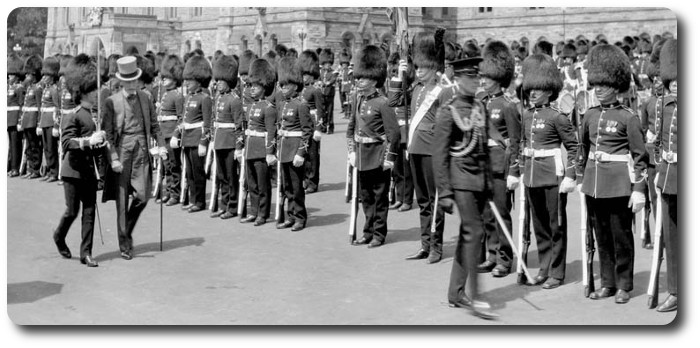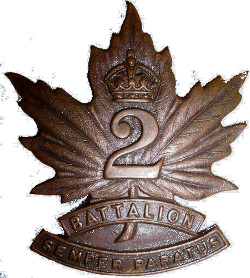Topic: CEF

Old Fighting Unit, Second Battalion, To Be Perpetuated
Brilliant Ottawa Regiment, G.G.F.G., to Carry on Traditions of One of Outstanding Units of C.E.F.
 Ottawa Citizen, 18 Dec 1931
Ottawa Citizen, 18 Dec 1931
Perpetuation of one of the most outstanding units of the old Canadian Corps has been granted to one of Canada's most brilliant regiments in the non-permanent active militia, the Governor General's Foot Guards, who will hereafter carry into militia history the name and achievements of the 2nd Canadian Infantry Battalion. In doing so the Foot Guards become associated also with the Peterborough Rangers, sharing with that regiment the perpetuation of the Second. Efforts of the Foot Guards extending over two years have thus been crowned with success; while the announcement has been received with pleasure by the former personnel of the 2nd Battalion.
Soliciting the co-operation of the 2nd Battalion historical committee in the selection of battle honours for their new colors, the Foot Guards have had the following recommended to them as most representative of the active service of the 2nd Battalion; St. Julien; Festubert, 1915; Pozieres; Vimy; Arleaux (which includes the action at Fresnoy on May 3, 1915); Hill 70; Passchendaele; Amiens; Drocourt-Queant; and Canal du Nord.
Only ten battle honours [of the First World War] may be carried on the color of any militia regiment, the remainder being recorded in the militia list. The 2nd Canadian Battalion enjoys the distinction of more than twenty such honours.
Originally drawn from all over Ontario, parts of Quebec and northern New Brunswick, the 2nd Battalion was later re-established on territorial lines and formed one of the four units comprising the Eastern Ontario Regiment. The others were the Princess Patricia's Canadian Light Infantry, the 21st Battalion, and the 38th Battalion. The new distinction thus sees Ottawa regiments perpetuating two battalions of the Eastern Ontario regiment, since the thirty-eighth traditions are carried on by the Ottawa Highlanders.
Commanding Officers
The first commanding officer of the 2nd Battalion was the late Major General Sir David Watson, K.C.B., of Quebec, who assumed charge when the battalion was mobilized at Valcartier in 1914. He was later promoted to the command of the 4th Canadian Division, and was succeeded by Brigadier General E. Swift, D.S.O., and officer who advanced to a brigade of the 5th Division. When this formation was dispersed for reinforcing purposes, General Swift took command of Canadian infantry operations in Siberia.
Lieut.-Colonel W.M. Yates, a Westerner from Swift Current, Sask., held command for a brief period and was succeeded by Brigadier General R.P. Clark, C.B., D.S.O., M.C., of Vancouver, B.C., a former commanding officer of the 14th (Royal Montreal Regiment) Battalion. The longest tenure, however, was that of Colonel L.T. McLachlin, C.M.G., D.S.O. (and two bars), of Bowmanville, Ont. This officer's administration continued from June, 1917, until demobilization in April, 1919.
The Adjutants
Adjutants of the 2nd Battalion were: Col. H. Willis O'Connor, D.S.O., Ottawa, Ont., the late Captain E.D. O'Flynn, Belleville, Ont., Major W.O. White, M.C., Toronto, Ont., Lieut-Col S.B. Pepler, Toronto, Major R. De W. Waller, M.C., Brandon, Man., and Captain W.W. Murray, M.C., Ottawa.
In Every Engagement
The 2nd Infantry Battalion participated in every engagement involving the 1st Canadian Division (the Old Red patch) during the war from the Second Battle of Ypres to the pursuit to Mons. It was the first Canadian unit to attack on the Somme in 1916, was specifically praised for its stubborn defence of Hill 70, made the deepest penetration of Canadian units in the two days of the Amiens fighting in August 1918, initiated the drive to Mons when it stormed across the Canal de la Sensee in October of that year and was the first organized unit of Canadian infantry to invade Germany, marching over the frontier at Poteau ay nine o'clock in the morning of December 4, 1918.
The battalion was demobilized at Kingston, Ont., on April 23, 1919, four years to the day from its "Bapteme de feu" at Ypres.

